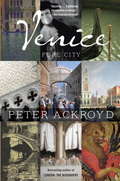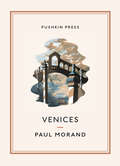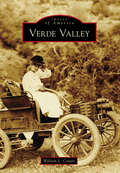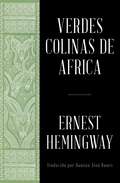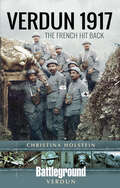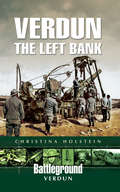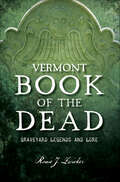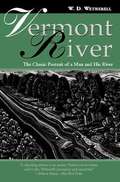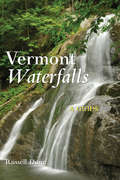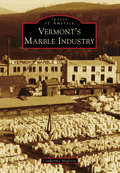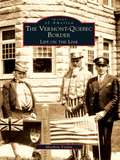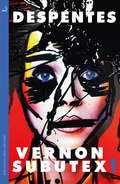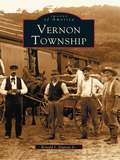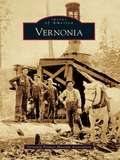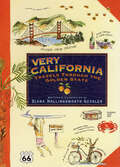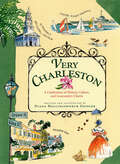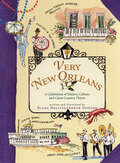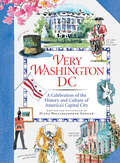- Table View
- List View
Venice: Four Seasons of Home Cooking
by Russell NormanA beautifully designed cookbook with easy, seasonal Italian recipes - perfect for any foodie!Russell Norman returns to Venice - the city that inspired POLPO - to immerse himself in the authentic flavours of the Veneto and the culinary traditions of the city. His rustic kitchen - in the residential quarter of the city where washing hangs across the narrow streets and neighbours don't bother to lock their doors - provides the perfect backdrop for this adventure, and for the 130 lip-smacking, easy Italian family recipes showcasing the simple but exquisite flavours of Venice.The book also affords us a rare and intimate glimpse into the life of the city, its hidden architectural gems, its secret places, the embedded history, the colour and vitality of daily life, and the food merchants and growers who make Venice so surprisingly vibrant.'Russell Norman is among the brightest stars of the British food scene' Esquire'Offers a rare insight into the beating heart of the city' i
Venice: Pure City
by Peter AckroydPeter Ackroyd at his most magical and magisterial -- a glittering, evocative, fascinating, story-filled portrait of Venice. In this sumptuous vision of Venice, Peter Ackroyd turns his unparalleled skill at evoking place from London and the River Thames, to Italy and the city of myth, mystery and beauty, set like a jewel in its glistening lagoon. His account is at once romantic and packed with facts, conjuring up the atmosphere of the canals, bridges and sunlit squares, the churches and the markets, the fiestas and the flowers. He leads us through the history of the city, from the first refugees arriving in the mists of the lagoon in the fourth century to the rise of a great mercantile state and a trading empire, the wars against Napoleon and the tourist invasions of today. Everything is here: the merchants on the Rialto and the Jews in the ghetto; the mosaics of St Mark's and the glass blowers of Murano; the carnival masks and the sad colonies of lepers; the doges and the destitute and the artists with their passion for colour and form -- Bellini, Titian, Tintoretto, Tiepolo. There are wars and sieges, scandals and seductions, fountains playing in deserted squares and crowds thronging the markets. And there is a dark undertone too, of shadowy corners and dead ends, prisons and punishment. The language and way of thinking of the Venetians sets them aside from the rest of Italy. They are an island people, linked to the sea and to the tides rather than the land. 'The moon rules Venice,' Ackroyd writes: 'It is built on ocean shells and ocean ground; it has the aspect of infinity. It is the floating world... changing and variable and accidental. 'This book, like a magic gondola, transports its readers to that sensual, surprising realm. We could have no better guide -- reading Ackroyd's Venice is, in itself, a glorious journey and the perfect holiday.
Venice: The Lion, the City and the Water (The\margellos World Republic Of Letters Ser.)
by Cees Nooteboom"You might think there is little new to say about Venice, but Cees Nooteboom strolls down many under-explored alleyways in the city, his insights coloured by his knowledge of art and literature as welll as his past experiences . . . Witty and meditative by turns, the overall effect is like being shown around by a wonderfully self-effacing, but impressively erudite guide" The Sunday Times BOOKS OF THE YEAR"Nooteboom has achieved the impossible: to say something new about the ageless city about which everything has been said" ALBERTO MANGUEL"The whole book is the illuminating testimony of a man who cannot look away and so sees things that others, even those with more specialist knowledge, have missed, whether it be the color and consistency ofthe ropes on the vaporetti, the glistening hues and squirming movements of the fish at the market, or the wondrous effects that Tintoretto could achieve with dabs of white in 'the gleam of armour, the folds in a sleeve, the windings of a turban, the halo of a man of the air who, as in the Last Judgment, is flying throughspace, in a wide flowing cloak . . .'" GREGORY DOWLING, Wall Street JournalVENICE: "A dream of palaces and churches, of power and money, dominion and decline, a paradise of beauty." By the author of Roads to Santiago and Roads to BerlinWith this treasury of his time spent in Venice over a period of fifty-five years, Nooteboom makes himself the indispensable companion for all lovers of "the sailing, amphibious city", and for every new visitor.Because he is a master storyteller with an inexhaustible curiosity, and always with a suitcase of books (to which new discoveries are added), he brings vividly and poetically to life not only the tumultuous history of the Republic but along the way its doges, its villains, its heroes, its magnificent painters, its architects, its scholars, its skies, its canals and piazzas and alleyways, and on his expeditions its "bronze voices of time".Those who know and love this city and its literature will recognise Nooteboom - in Laura Watkinson's fine translation - as the dazzling heir and companion to Montaigne, Thomas Mann, Rilke, Ruskin, Proust, Brodsky, and Donna Leon. His homage to Venice is a generous introduction, learned and enchanting, and worthy of its magnificent subject."His writing is lyrical and densely textured. He is a poet of time and memory" - COLIN THUBRONTranslated from the Dutch by Laura Watkinson
Venices
by Euan Cameron Paul Morand"It is after experiencing life that I have returned here to think about myself." Paul Morand was a diplomat, traveller, socialite and one of the most erudite and original writers of the twentieth century. Venices is his typically unconventional autobiography: an evocative account of a remarkable life lived surrounded by the remarkable. Its poised, impressionistic, poetically vivid scenes add up year-by- year to a rich meditation, full of astonish- ing portraits and memories, joy as well as melancholy. Though Morand's reputation was mar- red for years by his involvement with the collaborationist Vichy government, this book, in its effortless elegance, demonstrates why his influence has been so great. The thread that holds it taut throughout is Venice, the city to which Morand always returned.
Ventura County Motor Sports (Images of America)
by Tony BakerVentura County has a long tradition in motor sports, and area racing enthusiasts have done it all, whether on four wheels or two, on the road or off, in a straight line or a circle, or even on the water. Ventura County Motor Sports takes you back to the vintage years of the Central Coast car and racing culture with a new set of classic photographs. Visit the forgotten racetrack known as Oxnard Speedway, check out the hot-rodding scene in Ojai during the 1950s and 1960s, and meet some of the personalities from Ventura County that made their mark in the automotive and racing world, plus get a special look at local custom cars and some great motorcycle, off-road, and drag boat action from the golden years.
Verde Valley
by William L. CowanThis book celebrates the colorful history of the Verde Valley from its prehistoric settlements to the Arizona State Centennial Celebration in 2012. Located in the heart of Arizona, between the Sonoran Desert and the mountain highlands of the Colorado Plateau, the Verde Valley has been a pleasant refuge for man and beast for thousands of years. In a land known for its lack of water, the Verde River and its tributaries--Clear Creek, Beaver Creek, Oak Creek, and Sycamore Creek--have attracted prehistoric people and American pioneers alike. This book will illustrate the history of the "Verde" from the ruins of the lost civilization to the first Anglo farming efforts along Clear Creek and the military presence at Camp Verde. It will illustrate the settlements at Middle Verde and along Beaver Creek, Rimrock, Oak Creek, Cornville, and Sedona. Finally, it will visit the settlement near the Cottonwoods, the exploitation of the Billion Dollar Copper Camp at Jerome, the smoke-belching furnaces of the smelters, and the elegant architecture of the planned company town of Clarkdale.
Verdes colinas de africa (Spanish Edition)
by Ernest HemingwayUna obra maestra del reportaje donde el Premio Nobel de Literatura Ernest Hemingway cuenta la estancia de un mes—diciembre de 1933—en África, dedicado a una de sus grandes pasiones: la caza mayor.La luz africana, el paisaje febril, la excitación y la tensión que produce la cinegética se convierten para Hemingway en motivos de reflexión que van mucho más allá del safari y la simple narración turística. Como siempre, Hemingway logra elevar la anécdota a la categoría de mito, explorar la condición del hombre a través de sus instintos más primarios y, en definitiva, indagar en torno a la eterna cuestión de la muerte, el deseo y la supervivencia.
Verdun 1917: The French Hit Back (Battleground Verdun)
by Christina HolsteinA tour of the historic French battlefield that goes beyond the usual dates and places, and reveals the full story of the fighting after the fighting. Despite the popular view, the French army did not cease offensive operations after the disastrous Nivelle Offensive of spring 1917 and the subsequent mutinies. Nor did the fighting at Verdun come to an end in 1916.The successful French counteroffensives at the end of that year led to preliminary planning for a two Army operation in 1917 to break out of the Verdun salient and recapture the strategically very significant Briey coal basin. The French Army mutinies of May and June 1917 led to a more limited version of the plan being implemented, with the aim of establishing new lines for a breakout in 1918.The need to rebuild morale in the French army meant that nothing was left to chance. The immense logistical effort of this late summer 1917 campaign and the detailed planning and careful training at all levels brought success to an army weary of war but determined to win. The industrial nature of the preparations, the spectacular numbers of guns, and the first appearance of the Americans at Verdun presage the campaigns of 1918 and the final Allied victory.Christina Holstein, Britain’s premier expert in the battlefields around Verdun, leads the reader around the various vital points of this largely unknown battle of 1917, one which was crucial for the rebuilding of a French army that played such a notable part in the victorious Allied campaign of 1918. Like all the books in the Battleground Europe series, it is profusely illustrated and mapped using contemporary and modern material, with clear maps to support each of the tours.
Verdun: The Left Bank (Battleground Verdun)
by Christina HolsteinA Battle of Verdun specialist explores the lesser-known events of the left bank in this illustrated WWI history and battlefield guide. This fascinating study explores the background of the battle and casts light on the first three critical months of fighting there. It also explains fateful decision to change the original German offensive plan, extending the action to the Left Bank of the River Meuse. Using only original French and German sources, historian Christina Holstein describes the fighting on the Left Bank and follows the German offensive as it slowly pushed forward, taking three terrible months to reach its objectives: the two hills known as Cote 304 and the Mort-Homme, or Dead Man. The French defense of the Left Bank hills, described by Germans themselves as outstanding, is also covered in great detail. With intimate knowledge of the Verdun battlefield, Holstein describes the events in vivid detail and provides three walking tours through areas of the Left Bank rarely seen by visitors. This volume also contains more than 150 photographs, most of which have never been published before.
Vermont Book of the Dead: Graveyard Legends and Lore (The History Press)
by Roxie J. ZwickerVermont's hills hold the echoes of a spirited past. Haunting stories and wandering ghosts are found in numerous burial places from the Riverside Cemetery in Burlington to the Green Mount Cemetery in Montpelier. The Bowman mausoleum in Cuttingsville contains some heartbreaking symbolism. Throughout the state, disturbing tales of mountain madness, murder and "vampires" can be found carved in stone. Discover the graves of humble farmers with independent spirit like Justin Morgan, Ethan Allen, and "Snowflake" Bentley who changed the course of history. The ancient gravestones in Rockingham were once removed and put on exhibit in New York City, while innovative gravestone carvers from Barre to Bennington left artistic interpretations of death to awe and inspire. Author and tour guide Roxie Zwicker explores these historic and legendary graveyards.
Vermont River
by W. D. WetherellSelected by Trout magazine as one of the thirty finest fly-fishing books, "Vermont River" is the brilliant chronicle of a writer and fisherman. It is a book of rare and genuine beauty, a celebration of fly fishing, the natural world, and a river valley and the life in it. The first of Wetherell's trilogy lauding his love of a sport and a region, "Vermont River" is a must for anyone who loves good literature.
Vermont Waterfalls
by Russell DunnMore than 200 waterfalls, from town centers to roadsides to isolated natural areas For those who seek the special serenity that seems to be found near moving water, this guide to waterfalls in one of America's most beautiful states will be a blissful find in itself. Vermont Waterfalls: A Guide is illustrated with appealing antique postcards of some of the state's most famous falls as well as modern photographs of falls described here for the first time. Using the same successful geographic organization scheme employed in Connecticut Waterfalls: A Guide, the author makes it feasible to see several waterfalls in one trip. Detailed maps identify waterfalls by their proximity to Vermont's major roadways: US 7 in the west; route 100 bridging the center; and US5/I-91 to the east. With more than 200 entries that include the history of and directions to all these cataracts and cascades, this guide is meant for everyone--waterfall enthusiasts, photographers, hikers, artists, families . . .
Vermont's Marble Industry
by Catherine MiglorieThe marble deposits in Vermont are some of the richest in the world. Vermont's Marble Industry takes readers deep inside the quarries of the Green Mountain State to show how stone was sawed and raised from the earth to be cut, polished, and carved into monuments and structures that today are spread across the country. During the late 1800s, the marble industry flourished and the mighty Vermont Marble Company was started by a local family. The patriarch of the Proctor family built the Vermont Marble Company into the largest stone company in the world. They hired immigrant workers to fuel the company, and the region became a melting pot of nationalities. After World War II, demand for blocks of heavy dimension stone diminished and the slow demise of the Vermont Marble Company began. Vermont's Marble Industry proudly tells the history of the marble workers, their skilled craftsmanship, and the communities that relied on this industry.
Vermont-Quebec Border, The: Life on the Line
by Matthew FarfanThe Vermont-Quebec Border: Life on the Line is a visual record of life in the villages, towns, and countryside in this unique and special part of the world. In recent years, issues relating to the border have been thrust to the forefront as never before. This is due not only to growing security concerns but also to an increasing scrutiny in the media of border issues and of how heightened security is impacting life in communities all along the border. The border has played an important role in the history and everyday lives of the people living along its length, both in Vermont and Quebec, and it will undoubtedly continue to shape these communities in the years to come.
Vernon Subutex One: English edition
by Virginie Despentes**SHORTLISTED FOR THE MAN BOOKER INTERNATIONAL 2018**WHO IS VERNON SUBUTEX?An urban legend.A fall from grace.The mirror who reflects us all.Vernon Subutex was once the proprietor of Revolver, an infamous music shop in Bastille. His legend spread throughout Paris. But by the 2000s his shop is struggling. With his savings gone, his unemployment benefit cut, and the friend who had been covering his rent suddenly dead, Vernon Subutex finds himself down and out on the Paris streets.He has one final card up his sleeve. Even as he holds out his hand to beg for the first time, a throwaway comment he once made on Facebook is taking the internet by storm. Vernon does not realise this, but the word is out: Vernon Subutex has in his possession the last filmed recordings of Alex Bleach, the famous musician and Vernon's benefactor, who has only just died of a drug overdose. A crowd of people from record producers to online trolls and porn stars are now on Vernon's trail.VERNON SUBUTEX TWO IS PUBLISHED IN JULY 2018Translated from the French by Frank Wynne
Vernon Subutex One: the International Booker-shortlisted cult novel (MacLehose Press Editions)
by Virginie Despentes**SHORTLISTED FOR THE MAN BOOKER INTERNATIONAL 2018**WHO IS VERNON SUBUTEX?An urban legend.A fall from grace.The mirror who reflects us all.Vernon Subutex was once the proprietor of Revolver, an infamous music shop in Bastille. His legend spread throughout Paris. But by the 2000s his shop is struggling. With his savings gone, his unemployment benefit cut, and the friend who had been covering his rent suddenly dead, Vernon Subutex finds himself down and out on the Paris streets.He has one final card up his sleeve. Even as he holds out his hand to beg for the first time, a throwaway comment he once made on Facebook is taking the internet by storm. Vernon does not realise this, but the word is out: Vernon Subutex has in his possession the last filmed recordings of Alex Bleach, the famous musician and Vernon's benefactor, who has only just died of a drug overdose. A crowd of people from record producers to online trolls and porn stars are now on Vernon's trail.VERNON SUBUTEX TWO IS PUBLISHED IN JULY 2018Translated from the French by Frank Wynne(P)2019 Quercus Editions Limited
Vernon Subutex Three: A Novel (Vernon Subutex Ser. #3)
by Virginie DespentesAlthough it means leaving behind the community of disciples who have followed him on his travels and assembled at his raves and gatherings, Vernon Subutex is compelled to return to Paris to visit the dentist.Once back in the city, he learns that Charles, his old friend from his days on the Paris streets, has died and left him half of a lottery win. But when Vernon returns to his disciples with news of this windfall, it does not take long before his followers start to turn on each other, and his good fortune provokes ruptures in his once harmonious community.Meanwhile, storm clouds are gathering for Aïcha and Céleste: Laurent Dopalet is determined to make them pay for their attack on him, whatever it takes and whoever gets hurt. And before long, the whole of Paris will be reeling in the wake of the terrorist atrocities of 2015 and 2016, and all the characters in this kaleidoscopic portrait of a city will be forced to a reckoning with each other.
Vernon Township (Images of America)
by Ronald J. Dupont Jr.Vernon Township, located in the mountains of Sussex County, has grown from a town of farmsteads, mills, railroads, and schoolhouses to one of busy highways, lake communities, mountain resorts, and housing developments. Vernon's evolution from agriculture and industry to subdivisions and recreation, presented here in vivid historical photographs, will fascinate longtime residents, newcomers, and visitors alike. Vernon Township reveals a rare glimpse of the community in its early days.From Ice Age mastodons to Colonial taverns to the Playboy Club Hotel, Vernon Township covers the vast sweep of the community's rich and diverse heritage. This tour of Vernon's past includes antique images of homes, farms, stores, taverns, businesses, schools, churches, and industries. Also depicted are the evolution of local transportation from horse to train to automobile, notable past residents, and the growth of recreation from summer camps to fine hotels. Many of the unique historical views, some of which were reproduced from the original glass-plate negatives, have never before been published.
Vernonia (Images of America)
by Vernonia Pioneer Museum AssociationNestled in the Upper Nehalem Valley in the foothills of the Oregon Coast Range, Vernonia still reflects its pioneer virtues of hard work and independence. The area was first homesteaded in 1874 by Clark Parker and John Van Blaricom. The earliest settlers saw the dense old-growth firs and cedars as an obstacle to overcome in establishing farms, but those big trees soon became the lifeblood of the town's economy. Incorporated in 1891, Vernonia remained a small settlement with family-run farms, sawmills, and supporting businesses until the arrival of the long-awaited railroad in 1922. The Oregon-American Lumber Mill--at the time one of the largest of its kind--was built in 1923. The mill provided jobs and business opportunities for hundreds of people until 1957 when it closed. The population rapidly declined as people left to find work elsewhere. Vernonia has proved resilient, however, and continues to be home to over 2,000 residents who appreciate small-town life in a forested setting.
Vertical Disintegration in the Corporate Hotel Industry: The End of Business as Usual (Routledge Research in Hospitality)
by Angela RoperThis book evaluates how and why vertical disintegration has occurred in the global corporate hotel industry, as it undergoes a structural transformation. It provides a unique insight into the new competitive landscape. Underpinned by academic literature, it includes first-hand accounts from the most eminent senior executives of firms in and around the industry. It provides an in-depth perspective of a modern industrial phenomenon and makes observations as to the profitable way forward for the industry. This text is an important read for those working, advising and investing in the sector as well as for students, graduates and researchers.
Vertigo
by Michael Hulse W. G. SebaldThe beguiling first novel by W. G. Sebald, one of the most enormously acclaimed European writers of our time. Vertigo, W. G. Sebald's first novel, never before translated into English, is perhaps his most amazing and certainly his most alarming. Sebald--the acknowledged master of memory's uncanniness--takes the painful pleasures of unknowability to new intensities in Vertigo. Here in their first flowering are the signature elements of Sebald's hugely acclaimed novels The Emigrants and The Rings of Saturn. An unnamed narrator, beset by nervous ailments, is again our guide on a hair-raising journey through the past and across Europe, amid restless literary ghosts--Kafka, Stendhal, Casanova. In four dizzying sections, the narrator plunges the reader into vertigo, into that "swimming of the head," as Webster's defines it: in other words, into that state so unsettling, so fascinating, and so "stunning and strange," as The New York Times Book Review declared about The Emigrants, that it is "like a dream you want to last forever."
Very California: Travels Through the Golden State
by Diana Hollingsworth GesslerA fisherman on the Santa Monica Pier. The vineyards of Napa Valley. Surfers in Malibu. An Indian village in Yosemite and the Golden Gate Bridge at sunset. Artist Diana Gessler captures the color and character of our third largest and most populous state. In lively watercolors, sketches, and stories, Gessler shares her adventures on the road, driving from north to south--Sonoma to San Diego and beyond. She and her husband, Paul (designated driver and food lover), stop when curiosity or hunger seizes them.With pen and brush, Gessler works on the spot, bringing to life the cities, towns, and countrysides as well as the details that make them special. A great horned owl. A local farm stand. A woman making tortillas on a sidewalk cart. A bunkhouse in the redwoods. Crab traps along the bay. Her intimate journal is filled with colorful people, beaches, flowers, architecture, animals, trails, memorable meals, and movie stars (at least the gates in front of their houses). Very California is organized by region, and each chapter opens with a map and driving route of the area. Peppered throughout are amusing tidbits about all the things that make California so very California. Diana Gessler has created a memento for tourists and an enchanting book for those who appreciate the pleasures of the West Coast.
Very Charleston: A Celebration of History, Culture, and Lowcountry Charm
by Diana Hollingsworth GesslerCobblestone streets leading to perfectly preserved historic homes. Intricate wrought-iron gates opening to lush, fragrant gardens. A skyline of steeples and a river harbor bustling with schooners and sailboats. Charleston is one of America's most charming cities. In vibrant watercolors and detailed sketches, artist Diana Gessler captures the beauty and riches that make Charleston so unique: White Point Gardens, the Spoleto Festival, Rainbow Row, Waterfront Park, Fort Moultrie, the beaches of Sullivan's Island, sumptuous Lowcountry cuisine, and handmade sweetgrass baskets. Full of fascinating details--on everything from the art of early entertaining, the city's inspired architectural and garden designs, and George Washington's Southern tour to famous Charlestonians and the flags of Sumter--Very Charleston celebrates the city, the Lowcountry, the people, and our history. Hand-lettered and full color throughout, Very Charleston includes maps, an index, and a handy appendix of sites. With her cheerful illustrations and love for discovering little-known facts, Diana Gessler has created both an entertaining guide and an irresistible keepsake for visitors and Charlestonians alike.
Very New Orleans: A Celebration of History, Culture, and Cajun Country Charm
by Diana Hollingsworth GesslerThe exquisite antebellum mansions of the Garden District. Giant oaks stretching across boulevards and back in time to before the Civil War. The decadence of Bourbon Street. The vibrant sounds of jazz, blues, and Cajun music coming from every doorway or right from the street. Lacy iron balconies that wrap around the historic buildings of the French Quarter. A leisurely meal under a canopy of wisteria. In vibrant watercolors and detailed sketches, artist Diana Gessler captures the unique charm that makes New Orleans alluring: Mardi Gras, the Cabildo, Jackson Square, the Court of the Two Sisters, St. Louis Cemetery, the Jazz Festival, the River Road Plantations, the Cajun country, sumptuous Creole cuisine, and Audubon’s Aquarium of the Americas. In fascinating detail—on everything from the making of Mardi Gras, Napolean’s death mask, the city’s inspired architectural and garden designs, and favorite author hangouts to famous New Orleanians and Aunt Sally’s Creole pralines—Very New Orleans celebrates the city, the Cajun country, the people, and our history
Very Washington DC: A Celebration of the History and Culture of America's Capital City
by Diana Hollingsworth GesslerA travel guide with character, this fact-filled keepsake offers all the history, beauty, charm, and culture of our nation's capital city. In eye-catching watercolors and detailed sketches, artist Diana Gessler captures the allure that makes Washington DC one of the most visited destinations in the country. In addition to the national landmarks, stirring memorials, and vibrant neighborhoods, there's the Cherry Blossom Festival, the Twilight Tattoo (a military pageant featuring the Old Guard Fife and Drum Corps and the U.S. Army Drill Team), colorful row houses, famous hotels and restaurants, and more museums than you'll be able to visit in just one trip. Gessler covers the city's most popular attractions but also heads off the beaten path to share hidden gems, like the quirky Albert Einstein Memorial and Eastern Market, where you can dine on bluebucks and browse for flea market finds. Also included are an index of sites and a useful appendix of addresses, Web sites, Metro stops, and phone numbers. Very Washington DC is a picture-perfect guidebook—a one-of-a-kind memento for tourists and a cherished reminder of the city's riches for those who have always lived in America's hometown.

